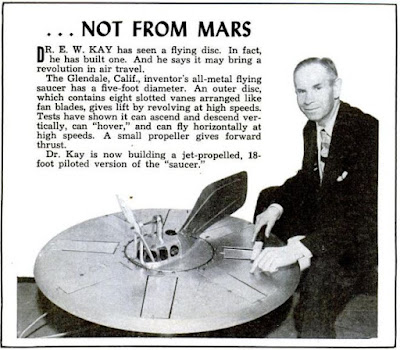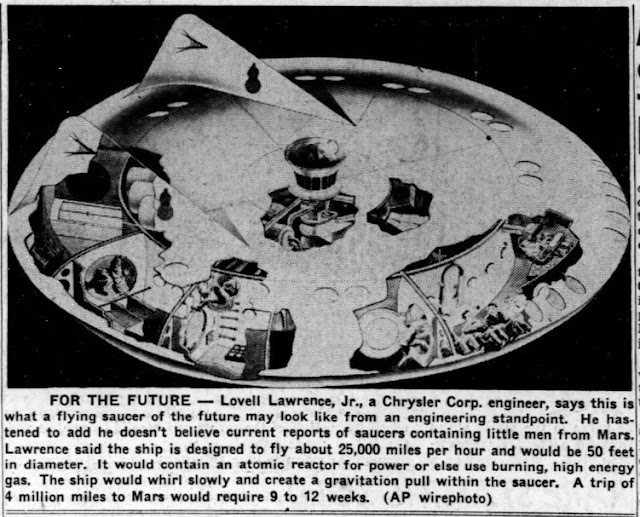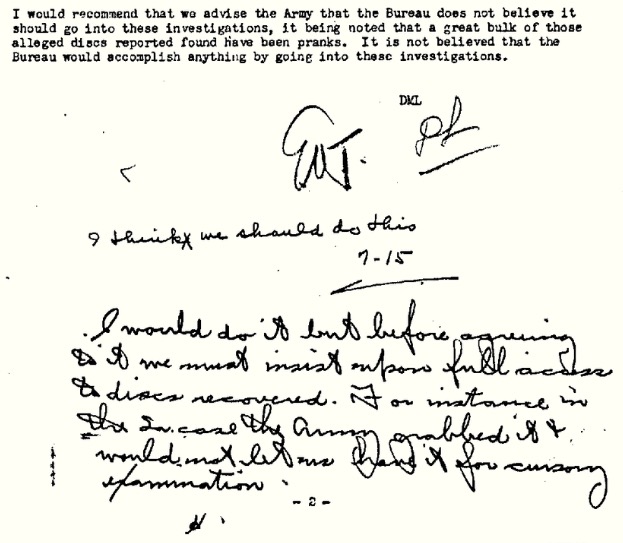There were circular winged aircraft before the sighting of flying saucers in 1947. At least two of them were later the cause of some confusion.
Jonathan E. Caldwell invented the Roto-Plane around 1937, but after the crash of a test flight he abandoned the project. Later the prototypes were found in a barn and mistaken for flying saucers.
In 1942, Charles H. Zimmerman built a single-wing circular airfoil, the Chance Vought V-173, nicknamed the Flying Flapjack (or Pancake). This propeller driven disk-shaped plane was tested in 190 flights up until March 1947.
 |
| The Los Angeles Times, July 6, 1947 |
 |
| Daily News, July 5, 1947 |
After the reports from Kenneth Arnold and others of disc-shaped unidentified flying objects, many inventors were inspired, challenged to build their own flying saucers. Here’s some notable examples from our files.
Engineering Flying Saucers: The First Ten Years
Dr. Kay’s Revolutionary Disc
Dr. Eugene W. Kay was a Russian-born inventor and aeronautical engineer who lived in Glendale, California. He and a partner applied for a helicopter patent in 1946. https://patents.google.com/patent/US2521012A/en?inventor=Eugene+W+Kay
Saturday Night Uforia included Dr. Kay’s press coverage extensively in the 2015 article, Saucer Summer Reading Fest (part five), but below are some of the highlights.
https://www.saturdaynightuforia.com/html/articles/articlehtml/saucsum5.html
A nationally syndicated photo in January 1950 debuted Dr. Kay’s invention:
“… a flying saucer that he built himself and that he believes will revolutionize aviation. His 41-inch, 20- pound test model rises from the ground and spins in a 36-foot circle... U.S. Air Force officials recently watched a test flight of Dr. Kay's revolutionary disk.”
 |
| The Orlando Sentinel Jan. 16, 1950 |
More press followed. Parade magazine, April 9, 1950, ran a pictorial feature on his invention and reported: “The Kay ‘saucer’ is actually a 41-inch circular aluminum disk with eight slotted vanes like fan blades. A midget motor spins the vanes and also powers a propeller for forward motion.”
Then in May, Flying magazine and Popular Mechanics.
 |
| Flying magazine, May 1950 |
 |
| Popular Mechanics, May 1950 |
That was the end of the press for the invention, partly due to the research being cut short. Dr. Kay died on Oct. 8, 1951, at the age of 66. The last we could find of Dr. Kay’s saucer was in Billboard magazine, Dec. 5, 1953. William Shilling was a booker in New York supplying talent and exhibits (like Hitler’s limousine) for sportsmen's shows. Kay’s flying saucer was added to his collection of attractions, but Shilling died of a heart attack in 1956. Its final fate is unknown.
The Flying Saucer Air Bus
A stunning color illustration of a flying saucer was published in October 1950, for Science and Mechanics magazine, Dec. 1950, painted by Arthur C. Bade. It was for the cover story, a three-page article written by George F. Miller, “Will ‘Flying Saucer’ Buses Lick Traffic Congestion?” The article began:
"Designed as a practical approach to some of tomorrow's transportation problems - especially through crowded cities and suburbs - the Air Bus, shown on the cover of this issue and the accompanying photos, incorporates a number of features regarded by aviation authorities as highly desirable. For commuting by air, it offers many advantages."
Miller briefly discussed the reality of UFOs:
“At first glance, today's skeptic would say, perhaps, “Oh that's just another wild dream resulting from too much talk about ‘flying saucers!’ That is untrue. Many authorities still do not admit the existence of flying saucers, even where good descriptions have been supplied by persons who have claimed to see the strange craft. But no one can deny that the reported shape of a flying saucer would be airworthy if properly designed. We believe the air bus design, on which patents are pending, would be flyable and qualified aeronautical engineers who have checked our calculations agree.”
The Air Bus was designed to be 65 feet in diameter and 10 1/2 feet high, and weigh from 80,000 to 110,000 pounds. It would fly passengers at 90 to 175 miles an hour, lifted by three counter-rotating pairs of 14-foot diameter rotors. Each rotor pair would be driven by a pancake-type 2,400 horsepower engine.
Newspapers picked up on the story and widely printed a black and copy of Arthur C. Bade’s painting with a summary of Miller’s article.
CITY "SAUCER" The "flying saucer" will come into its own one day as the solution to traffic congestion in most U.S. cities, thinks designer George F. Miller of Chicago. Above is Miller's conception of a saucer-shaped, 100 passenger air bus that would carry city commuters at 90 to 175 miles an hour. Miller's idea was presented in Science and Mechanics magazine.
We had no luck find a patent for the Air Bus, but George Francis Miller did file a copyright for his article.
The First Sports Model
In November 1950, U.S. newspapers carried an exciting photo of a dynamic disc-shaped object built by aviation engineer, Nick Stasinos.
“Non-Flying ‘Flying Saucer’ - This model ‘flying saucer’ was built by Nick Stasinos of Inglewood, Calif., on order for a New York museum. The craft, called the ‘Experimental NS-97,’ shows two main jet installations in the center section and eight turbo-jet ports on the outer revolving disc. Considered aerodynamically practical, the saucer is not scheduled for production now"
The unnamed customer was Ripley's Believe It Or Not Museum in New York City. Like many others, the final fate of Stasino’s saucer is unknown.
Flying Further into the Fifties
In Frankfurt Germany, a propeller-driven flying saucer was designed by Walter Otto Galonska, as shown below in this 1951 news photo.
The Press and Sun-Bulletin, Jan. 2, 1951 - via Acme Telephoto
Engineers and artists had some high-flying expectation for man-made saucers, but the product never quite lived up to their dreams. Alexander Leydenfrost was an illustrator for pulp science fiction magazines before going to work for Life magazine. His work there rarely gave him the opportunity to revisit spaceships and such until Life magazine, May 31, 1954.
“The U.S. is seriously considering building a flying saucer… designed by a shy, 35-year-old English-born engineer named John C. M. Frost… It is the outgrowth of a saucerlike craft called ‘Project Y’ which Frost designed for his employers, A. V. Roe Canada Ltd.”
 |
| Life magazine, May 31, 1954 |
At Fort Hood, Texas, the U.S. Army's private Larry G. Anderson was building and launching his own flying saucers.
Chrysler’s Saucer Spaceship
Lovell Lawrence Jr, an assistant chief engineer at Chrysler Missiles Operations, publicized his concept for a nuclear-powered “flying saucer.” It was featured in an Associated Press story carried in The Bridgeport Post, Dec. 30, 1956. Lawrence was confident the spaceship could be built and said, “Space travel is inevitable, and the only question is when.”
 |
| San Bernardino Sun, March 1957 |
Check the links below for further information on Lawrence's concepts.
The Bridgeport Post, Dec. 30, 1956: …Space Ships May Make it Possible
Aerospace Projects Review Blog: The Chrysler Saucer
That concludes this look at plans and attempts to build man-made flying saucers. Be sure to check our past articles for more disc engineering attempts, and keep watching the skies.













.png)





































